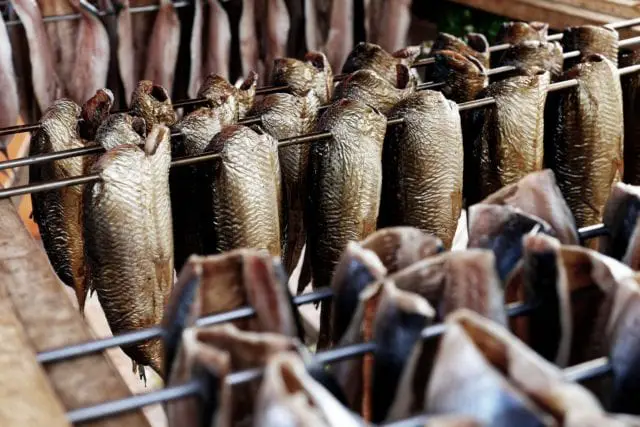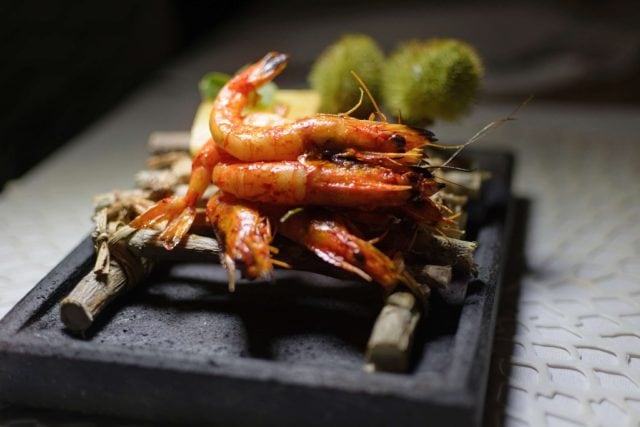Table of Contents
Overview [Drying Fish & Seafood]
Dried fish and seafood are common ingredients in Asian and Cajun cuisines. It makes sense because of their geographical location. Sun drying is a common method of food preservation.
Have you been to any Asian or South American country? Have you seen their dried fish market teeming with all kinds of dried fish and seafood varieties? You may think that all fish and seafood can’t be dried that easily.
Not really.
For food drying at home, it is best to choose fresh (not frozen) lean fish like cod, halibut, bass, and sole. Although you may choose a few fatty or oily fish, these types may spoil rapidly if not dried well.
One of our sources mentioned that drying these types of fish is not advisable due to its high-fat content. Take a look at their percentage of fat below:
- Catfish, also known as “mudcat”, “polliwogs”, or “chuckleheads contains 5.2% fat
- Lake Trout fish is also known as mackinaw, namaycush, lake char, touladi, togue, grey trout, siscowet, paper belly and lean has 11% fat
- Mackerel contains 9.9% fat and one of the good sources of omega-3 fatty acids
- Mullet contains 6.0% fat
- Rainbow Trout contains 6.8% fat
- Salmon has 9.3% fat
- Whitefish, a subfamily of Salmon, has 7.2% fat
Seafood like shrimp, lobster, and crab are low in fat and can be dried. In some Asian countries, crab is better fermented than dried. But before drying, these should be cooked first. Squid is dried fresh.
What is keto?
Discover the Health benefits Keto can offer! It turns out fish is healthy and keto-friendly!

In this article, we will discuss how to dry fish and seafood like shrimp and squid at home.
Getting Started With Dried Fish

- Clean the fish removing the scales, gills, and intestines.
- For small and medium-size fish, make a butterfly cut from the head down to the tail and spread it open. Deboning a fish is optional.
- For big-size fish, either you cut them into butterfly or fillet-size and deboned.
- Season the fish with a marinade. Your marinade could be 1 ½ to 2 tsp. salt for every pound of fish, your choice of seasonings, and ¼ cup of water. Salt prevents bacteria from growing during the drying process.
- Marinate the fish for 4 to 8 hours in the refrigerator to allow the flavors to seep in.
- Drain the marinade well before drying. Lay them on the drying trays without overlapping.
- Dry the fish in the dehydrator at 160°F for around 10 hours until it is firm, dry, and pliable. If you still see moisture on the fish, continue drying.
- Be careful not to over-dry the fish. If the fish falls apart after bending it, it’s over-dried.
- Dried fish can be stored in sealable plastic bags, glass jars, or airtight plastic containers. Store them in dark, dry place at room temperature for not more than two months.
- Fish jerky is usually cooked before eating. Fry them in a small amount of oil. Or add them in soups and chowders.
How to Dry Shrimp

- Clean shrimp and devein.
- Boil shrimp in salty water until it turns pink or orange.
- Dry them in paper towels
- Dry them in dehydrator at 145°F for 4 to 6 hours until they’re hard
- Use dried shrimp in many recipes like fried rice, noodles, gumbo and other stews, soups or chowders, salads, and dips.
- Or you can rehydrate them when the recipe calls for a regular shrimp. Add ½ cup of water for every 1 cup of dried shrimp and refrigerate for an hour. Drain well and store in the refrigerator until it’s time to use the rehydrated shrimp.
How To Dry Squid
- Dried squid is sun-dried fresh squid. It’s rare that you could find online information on drying squid using a dehydrator. But if you’ll do, it will be a trial and error method.
- Clean squid by removing the eyes and organs. The fins, softshell in the middle, and beak remain.
- Cut the squid lengthwise on the abdominal side, making the plastic-like spine in the middle when spread out.
- Wash the squid in seawater to remove contaminants. Then wash them in freshwater to remove the salt.
- Sun-dry the squid for 7 hours, it’s inside out
- Collect them and air-dry them under shade for an hour
- Sundry them again for one hour
- Collect the squid late in the afternoon when the temperature gets cooler
- Sun-dry the squid the following day, this time outside out
- Flatten the body and tentacles by spreading some oil and rolling a bottle over it.
- Dried squid is a little hard, dry, and pliable.
- You can fry the dried squid in a small amount of oil for a minute or two. It usually curls up on hot oil, so it is recommended to flatten it using your turner while frying. Serve immediately. Cooled fried dried squid could become chewy.
- Or you could roast dried squid over hot coals. Grilled dried squid is best served with spicy vinegar dip.
- You can also slice or flake dried squid and spice them for snacks.
Final Thoughts
Although you can still dry fish using an oven, drying fish in a food dehydrating machine is much better. Not only it may take away almost 6 hours of sun drying but also it could be done indoors.
Have you tried drying fish or seafood at home using a food dehydrator? Tell us your story!

